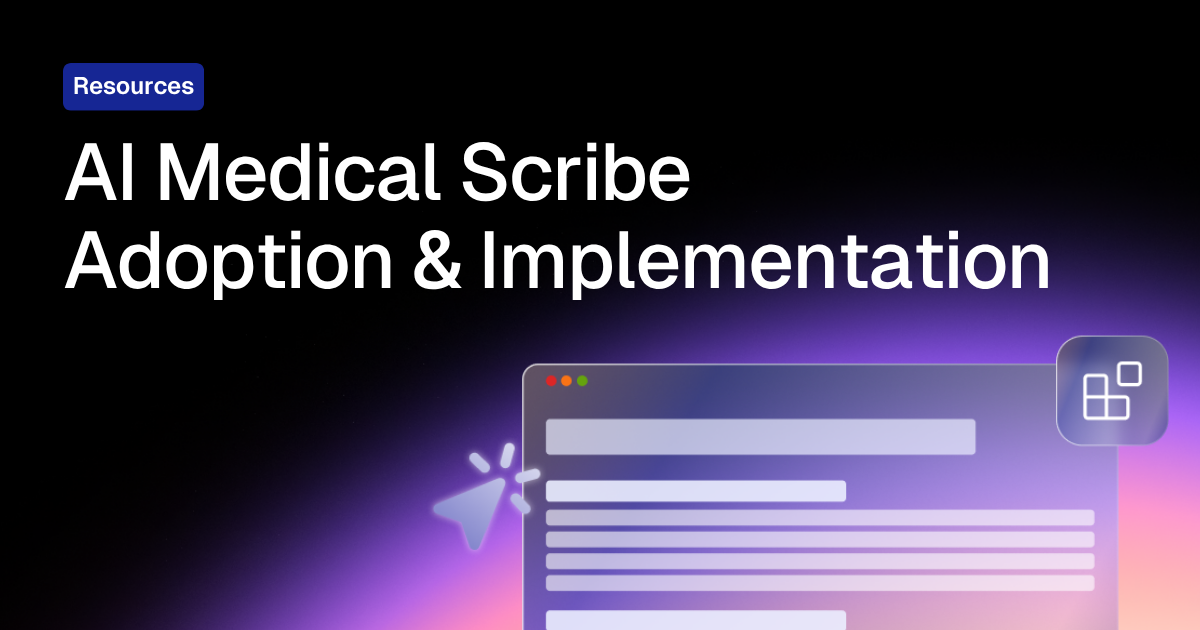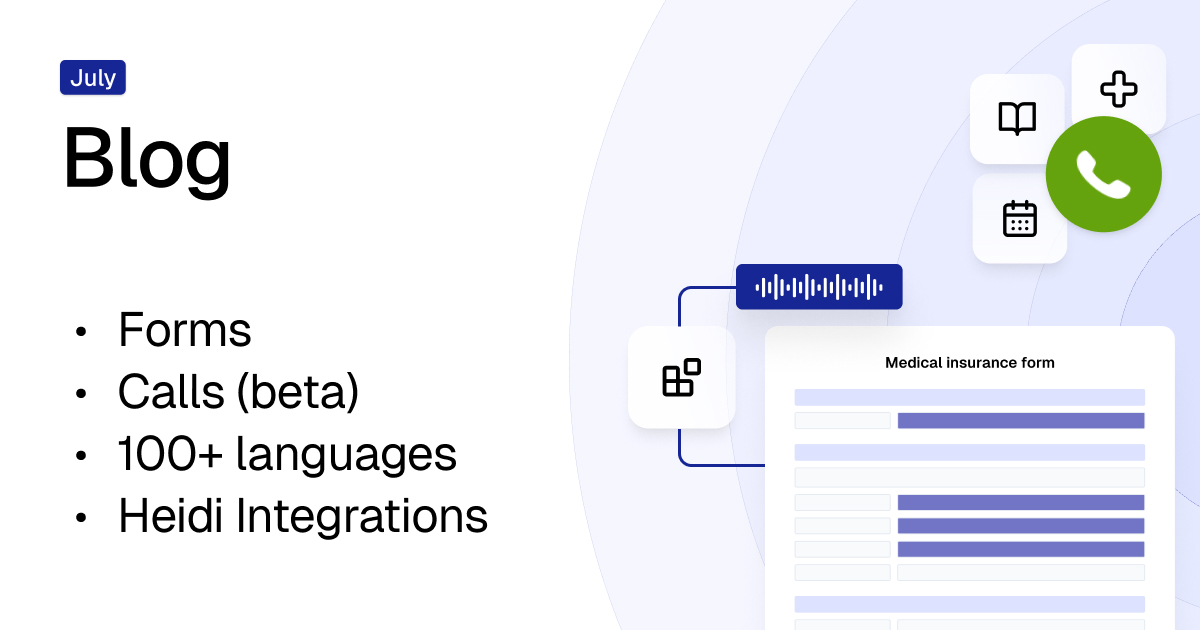Team Care Arrangement with Examples

Medicare Team Care Arrangement Template
This Team Care Arrangement (TCA) Notes Template Item 723 is designed to assist General Practitioners (GPs) in documenting comprehensive care plans for patients requiring coordinated healthcare services. With Heidi, the AI medical scribe for all clinicians, you can instantly generate TCA templates that:
- Capture essential details including patient medical and family history, current medications, allergies, and treatment goals.
- Identify key healthcare providers, necessary allied health services, and specific arrangements to facilitate coordinated and effective care.
- Monitor treatment progress and patient compliance with prescribed actions to optimize health outcomes and care continuity.

What is a Team Care Arrangement Template?
A Team Care Arrangement (TCA) Template is a structured document used by healthcare providers to outline and coordinate multidisciplinary care for patients with chronic or complex conditions.
In this article, we’ll discuss the importance of TCA templates, the common challenges in TCAs and how to overcome them, and a step-by-step guide to creating an effective TCA template. Finally, we’ll be sharing customizable and AI-enabled TCA templates you can use for your medical practice.
Why is a Team Care Arrangement Template Essential?
TCA templates streamline communications between healthcare providers, ensure compliance with Medicare requirements, and improve patient outcomes by supporting and coordinating multidisciplinary care plans. Additionally, they help maintain clear and consistent documentation, reduce errors, and improve care continuity.
How to Overcome the Common Challenges of Team Care Arrangements
While effective team care arrangements improve patient outcomes, the process of creating and implementing the TCA itself can be quite complex. Let’s talk about the common challenges of TCAs, along with some practical tips to overcome them:
1. Incomplete or Inaccurate Patient Information
It’s critical that the patient’s medical history, allergies, and current medications are thoroughly documented in the TCA since they have a direct impact on the success of the eventual care plan.
Solution: Implement standardized intake forms and AI-assisted documentation tools to ensure that information collected is both complete and accurate.
2. Lack of Clear Communication Among Providers
Misalignments can happen between GPs, specialists, and allied health professionals which can cause delays in treatment. For example, a GP might update the TCA with a new medicine, but fail to notify allied health providers, which can cause confusion in treatment adjustments.
Solution: Use a shared digital system or documentation tool that facilitates real-time updates.
3. Difficulty in Identifying the Right Allied Health Providers
Finding and coordinating with the right specialists can be time-consuming. Aside from considering the patient’s specific needs, your selected provider’s availability must also align with your care plan’s schedule.
Another consideration is whether the specialist you’ve selected accepts Medicare, or is Medicare-eligible if your practice is based in the USA, Australia, or New Zealand.
Solution: Maintain an updated referral directory which includes each specialist’s credentials, availability, and Medicare billing status (if applicable). You can also look into automated referral tracking systems that can quickly match your patient with the right allied health providers based on eligibility, service type, and location.
4. Compliance with Medicare Requirements
Meeting all required documentation and billing codes are met in your TCA can be challenging. Incomplete or incorrect submissions can result in rejected claims, audits, or even financial penalties.
Solution: Regularly check for Medicare updates and training resources to ensure accurate billing. You can also use AI-driven medical scribes that can auto-check documentation, flag missing details, and suggest the correct billing codes to reduce errors.
5. Patient Engagement and Adherence Issues
A major challenge in the success of TCA plans is ensuring that patients actively participate in their care plan. Even with a well-structured TCA, patients may still fail to follow through with recommended treatments, appointments, or lifestyle treatments. These can lead to poor health outcomes and ineffective care coordination.
Solution: Provide clear, personalized instructions to explain each step of the care plan, why it’s necessary, and the expected health benefits. Involve the patient in goal-setting so they’re more likely to stay committed. Use digital reminders and follow-up systems e.g., automated SMS, emails, or app-based notifications to encourage adherence.
Step-by-Step Guide to Creating a Team Care Arrangement Template
An effective TCA comes from structuring a clear, organized, and compliant document. Follow the step-by-step guide below to creating an effective TCA template:
Step 1: Gather Essential Patient Information
Start with a section for collecting basic patient details including their full name, date of birth, contact information, and Medicare or private insurance details. This must also include information for their primary GP and other designated carers.
Lastly, dedicate some space to document the patient’s past medical history, family history, current medications, and allergies, to come up with a comprehensive clinical background. This will serve as the basis for the rest of the TCA.
Step 2: Define Patient Goals and Treatment Objectives
Next, outline specific and measurable health goals for the patient e.g., “Maintain HbA1c below 7%”. It’s important that goals are realistic and patient-centered to encourage adherence and progress-tracking, eventually leading to positive health outcomes.
Step 3: Identify Required Treatments and Services
With the goals clearly outlined, you can now list the necessary interventions such as medication adjustments, dietary modifications, exercise programs, or therapy sessions. Include and specify patient responsibilities e.g., self-monitoring blood pressure, attending physiotherapy etc.
Step 4: Assign Healthcare Providers and Schedule Appointments
Identify and document the GP, specialists, and allied health providers responsible for each aspect of the patient’s care. Record appointment dates, along with each provider’s contact details and their respective roles in the established care plan.
Step 5: Establish a Follow-up and Review Plan
Set a review date to assess patient progress, adjust the care plan as needed, and schedule regular check-ins to ensure treatment adherence and provider coordination. You can make this easier by using automated reminders via SMS, email etc. to enhance engagement and encourage continuous communication.
Team Care Arrangement (TCA) Example
Here’s a free TCA example in PDF and Google Doc form.

TCAs require detailed documentation, seamless coordination, and Medicare compliance. Trying to tick all of these boxes manually can be tedious and complex. Thankfully, AI-powered TCA templates can now simplify this process while ensuring both accuracy and efficiency.
Priority Physicians, a primary care provider based in the Midwest, was able to save over 100 hours in documentation time after just 14 weeks of using Heidi.
“I used to spend two to two-and-a-half hours writing notes for a full day of seeing patients. Now with Heidi, I’ve got that down to around 40 minutes.” – Dr. Shelagh Fraser, Director of Medical Excellence and Innovation at Priority Physicians.
Easily Complete HPI Templates with Heidi
Heidi is our state-of-the-art AI medical scribe designed to help healthcare providers complete TCA templates in real-time. With your patient’s permission, simply hit record and let Heidi work as you go. Here’s how Heidi helps you complete your TCA plan:
- Transcribe – Open Heidi on your computer or mobile device and press Start so Heidi can capture your conversation in the background. For information that you don’t want to verbalize, you can type them under context notes to be considered later.
- Customize – After the session, simply select your preferred TCA template and watch as Heidi perfectly transcribes the details of your conversation and context notes in the appropriate fields and format!
- Transform – After generating your completed TCA template, you can ask Heidi to give additional documentation including referral letters or patient summaries as needed.
Heidi complies with jurisdiction-specific regulations, ensuring data localization for customers in Australia, Canada, the United States, the United Kingdom, and beyond. Read more about our compliance here.
Free Team Care Arrangement Templates
Team Care Arrangement Psychology Template
This TCA for Depression and Anxiety Disorders Template is designed to help General Practitioners (GPs) document and manage patient care plans based on the latest guidance from the Australian government. It includes sections to capture patient information, medical history, medication management, and specific goals for improving mental health.
Basic TCA Template
This Basic TCA Notes template helps GPs coordinate comprehensive care for patients with chronic conditions. It facilitates the documentation of treatment goals, services provided by collaborating healthcare providers, as well as the patient’s responsibilities within the care plan.
Team Care Arrangement Review Template
This General TCA Review Template - Item 732 is used by GPs to evaluate and update a patient’s TCA plan based on the latest guidance from the Australian government. It facilitates the review of care goals, checks progress, and determines the need for treatment plan adjustments.
FAQs About Team Care Arrangement Templates
Which patients are eligible for Team Care Arrangements?
Patients with chronic or complex medical conditions requiring the expertise of multiple specialists and allied health providers are eligible for TCAs. Eligibility is typically determined by a General Practitioner following Medicare guidelines.
How often should Team Care Arrangements be reviewed?
TCAs should be reviewed as often as clinically necessary. While a general recommendation of once every six months apply to most cases, they can be done sooner if the patient’s condition changes or if immediate adjustments to the care plan are deemed necessary by the healthcare providers involved.
What’s the difference between a GP Management Plan and a Team Care Arrangement?
A GP Management Plan or GPMP is a structured care plan created by GPs to manage a patient’s chronic condition, while a TCA is an extension of the GPMP that coordinates care with two or more allied health providers or specialists. A GPMP can exist as a standalone, while a TCA typically requires a GPMP as its foundation.
.webp)
Know more. Feel clever.
No-nonsense goodies about the latest in MedTech from your friends at Heidi.
Meet your AI resident.
It’s like you, but less gorgeous.
%201.png)
.svg)






